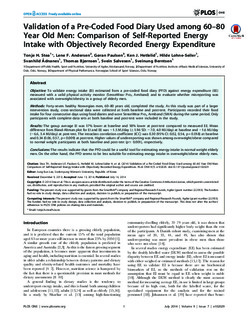| dc.contributor.author | Stea, Tonje H. | |
| dc.contributor.author | Andersen, Lene F. | |
| dc.contributor.author | Paulsen, Gøran | |
| dc.contributor.author | Hetlelid, Ken J. | |
| dc.contributor.author | Lohne-Seiler, Hilde | |
| dc.contributor.author | Ådnanes, Svanhild | |
| dc.contributor.author | Bjørnsen, Thomas | |
| dc.contributor.author | Salvesen, Svein | |
| dc.contributor.author | Berntsen, Sveinung | |
| dc.date.accessioned | 2014-09-15T08:13:38Z | |
| dc.date.available | 2014-09-15T08:13:38Z | |
| dc.date.issued | 2014 | |
| dc.identifier.citation | Stea, T. H., Andersen, L. F., Paulsen, G., Hetlelid, K. J., Lohne-Seiler, H., Ådnanes, S., . . . Berntsen, S. (2014). Validation of a Pre-Coded Food Diary Used among 60–80 Year Old Men: Comparison of Self-Reported Energy Intake with Objectively Recorded Energy Expenditure. PLoS One, 9(7), e102029. doi: 10.1371/journal.pone.0102029 | nb_NO |
| dc.identifier.issn | 1932-6203 | |
| dc.identifier.uri | http://hdl.handle.net/11250/219686 | |
| dc.description | Published version of an article from the journal Plos One. Also available from the publisher: dx.doi.org/10.1371/journal.pone.0102029 Open Access | nb_NO |
| dc.description.abstract | Objective: To validate energy intake (EI) estimated from a pre-coded food diary (PFD) against energy expenditure (EE)
measured with a valid physical activity monitor (SenseWear Pro3 Armband) and to evaluate whether misreporting was
associated with overweight/obesity in a group of elderly men.
Methods: Forty-seven healthy Norwegian men, 60–80 years old, completed the study. As this study was part of a larger
intervention study, cross-sectional data were collected at both baseline and post-test. Participants recorded their food
intake for four consecutive days using food diaries and wore SenseWear Pro3 Armband (SWA) during the same period. Only
participants with complete data sets at both baseline and post-test were included in the study.
Results: The group average EI was 17% lower at baseline and 18% lower at post-test compared to measured EE. Mean
difference from Bland-Altman plot for EI and EE was 21.5 MJ/day (61.96 SD: 27.0, 4.0 MJ/day) at baseline and 21.6 MJ/day
(26.6, 3.4 MJ/day) at post-test. The intraclass correlation coefficient (ICC) was 0.30 (95% CI: 0.02, 0.54, p = 0.018) at baseline
and 0.34 (0.06, 0.57, p = 0.009) at post-test. Higher values of underreporting was shown among overweight/obese compared
to normal weight participants at both baseline and post-test (p# 0.001), respectively.
Conclusions: The results indicate that the PFD could be a useful tool for estimating energy intake in normal weight elderly
men. On the other hand, the PFD seems to be less suitable for estimating energy intake in overweight/obese elderly men. | nb_NO |
| dc.language.iso | eng | nb_NO |
| dc.publisher | Public Library of Science | nb_NO |
| dc.rights | Navngivelse 3.0 Norge | * |
| dc.rights.uri | http://creativecommons.org/licenses/by/3.0/no/ | * |
| dc.title | Validation of a pre-coded food diary Used among 60–80 year old men: Comparison of self-reported energy intake with objectively recorded energy expenditure | nb_NO |
| dc.type | Journal article | nb_NO |
| dc.type | Peer reviewed | nb_NO |
| dc.subject.nsi | VDP::Medical disciplines: 700::Health sciences: 800::Nutrition: 811 | nb_NO |
| dc.source.pagenumber | e102029 | nb_NO |
| dc.source.issue | PLoS ONE | nb_NO |
| dc.identifier.doi | 10.1371/journal.pone.0102029 | |

